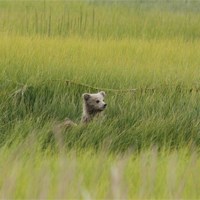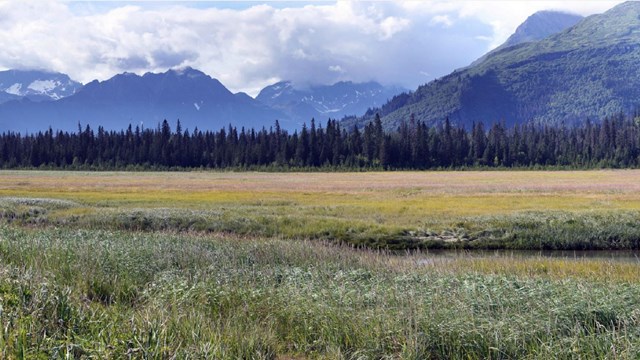|
Visit our keyboard shortcuts docs for details
What makes a salt marsh special? Join NPS scientists from the Southwest Alaska Inventory and Monitoring Network as they work on the Lake Clark's isolated coast to find out! 
NPS Photo / C. Carson During low tide bears leave the salt marshes for the adjacent mud flats to dig razor clams and other bivalves. Tidal streams bisecting the salt marshes provide nursery habitat for a variety of juvenile fish. In late summer, salmon enter the salt marsh streams on their way to their spawning grounds. As salmon arrive, bears transition from sedges to salmon in preparation for the upcoming winter months. Waterfowl, shorebirds, song birds, moose, river otters, and other small mammals can also be found using these marshes. Coastal salt marshes comprise less than 1% of Lake Clark National Park and Preserve yet are critical to the survival of the park's coastal brown bears. The importance of the salt marshes to the ecology of the park has prompted National Park Service scientists to monitor the condition of these vital systems. 
West Cook Inlet Ecology
Dive in to learn how the Cook Inlet Coast is an extremely dynamic ecosystem. For More Information Science in the sedgesSalt Marsh Monitoring
Silver Salmon Creek
Silver Salmon Creek boasts plentiful bear viewing opportunities and a steady coho salmon run. 
Chinitna Bay
Bear viewing is one of the main attractions at this gorgeous site on the Cook Inlet coast. Brown bears gather in the coastal salt marshes. 
Checklist: Common Salt Marsh Plants
Brush up your knowledge of common sedges, grasses, flowers, and other plants of the Cook Inlet Coast. 
Common Showy Flowers of Cook Inlet
Look closer at common showy flowers to learn how to identify and where to find them. 
Sedges and Grasses of Cook Inlet
Get a closer look at common salt marsh sedges and grasses and how to identify them. |
Last updated: December 16, 2020
